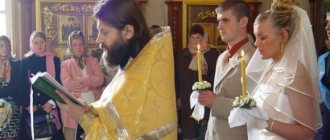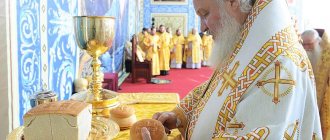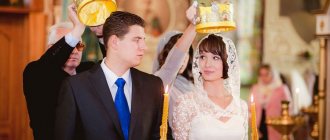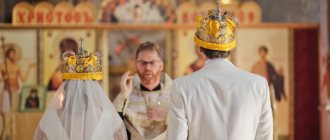RITE OF THE SACRAMENT OF WEDDING. PERMISSION OF THE CROWNS ON THE “EIGHTH DAY”
From the book of Herman Szymansky “Liturgics: Sacraments and Rites”
The ceremony of marriage should always be performed in church, and moreover, the most appropriate time for marriage is indicated to be the time after the liturgy.
Each marriage is supposed to be performed separately, and not several marriages together.
The rite of marriage consists of: 1) the rite of betrothal and 2) the sequence of wedding and resolution of crowns, i.e., the performance of the sacrament itself.
In the betrothal, “the word spoken by the spouses” is affirmed before God, that is, the mutual promise of the spouses, and as a pledge of this they are given rings; in the wedding, the union of the newlyweds is blessed and the grace of God is asked for them. In ancient times, betrothal was performed separately from wedding. Nowadays, a wedding usually follows immediately after an engagement.
The ceremony of betrothal. Before the betrothal, the priest places for consecration on the throne on the right side the rings (“rings”) of the newlyweds (one next to the other), while the silver one (which after the change goes to the groom) is placed on the throne on the right side of the gold one. The rings are placed on the throne as a sign that the union of the betrothed is sealed by the right hand of the Almighty and that the couple entrust their lives to the Providence of God.
For the betrothal, the priest, having put on the epitrachelion and phelonion, leaves the altar through the royal doors. He takes with him the cross and the Gospel in front of the lamp and places them on a lectern in the middle of the temple. The cross, the Gospel and the candle serve as signs of the invisible presence of Christ the Savior.
The betrothal takes place in the vestibule of the temple or at the very entrance to the temple (in the “entrance of the temple”).
The priest (three times) blesses the groom in a cross pattern, and then the bride with a lighted candle, which he then hands to everyone, showing that in marriage the light of the grace of the sacrament is taught and that for marriage a purity of life is necessary, shining with the light of virtue, why lighted candles are not given second marriage as no longer a virgin.
Then (according to the Rules) the priest censes them in the shape of a cross, indicating prayer and the teaching of the blessing of God, the symbol of which is incense, as a means of repelling everything hostile to the purity of marriage. (Currently, censing of the bride and groom before betrothal is not performed.)
After this, the priest makes the usual beginning: “Blessed is our God...” and pronounces a peaceful litany, which contains petitions for the spouses and for their salvation, for sending them perfect love and preserving them in unanimity and firm faith.
After the litany, the priest reads two prayers aloud, in which the betrothed asks for God’s blessing, unanimity, a peaceful and blameless life, etc. At the same time, the marriage of Isaac and Rebekah is remembered as an example of virginity and purity for the newlyweds. At this time, the deacon goes to the altar and brings rings from the throne.
The priest, having first taken the golden ring, overshadows the groom three times on his head, saying (three times):
“THE Servant of GOD (name) IS ENGAGED TO THE Servant of GOD (name) IN THE NAME OF THE FATHER AND THE SON AND THE HOLY SPIRIT, AMEN,”
and places the ring on the finger of his right hand (usually on the fourth finger).
In the same way, he hands over a silver ring to the bride, saying the words: “THE Servant of GOD (name) IS ENGAGED TO THE Servant of GOD...”.
After this, the rings are changed three times, and thus the bride’s ring remains as a pledge with the groom, and the groom’s ring remains with the bride.
By presenting the rings, the priest reminds the newlyweds of the eternity and continuity of their union. The subsequent three-fold change of rings indicates mutual consent, which must always exist between the spouses, and its completion by the successor or one of the relatives shows that the mutual consent of the spouses also includes the consent of their parents or relatives.
Having placed the rings on the right hands of the betrothed, the priest pronounces the betrothal prayer, in which he asks the Lord to bless and confirm the betrothal (Greek aеоа ona - pledge, cf. 2 Cor. 1, 22; 5, 5; Eph. 1, 14), like since He confirmed the betrothal of Isaac and Rebekah, blessed the position of the rings with a heavenly blessing, in accordance with the power shown by the ring in the person of Joseph, Daniel, Tamar and the prodigal son mentioned in the Gospel parable, confirmed the betrothed in faith, unanimity and love, and gave them an Angel Guardian all the days of their lives.
Finally, a short litany is pronounced: “Have mercy on us, O God...”, which happens at the beginning of Matins, with the addition of a petition for the betrothed. This ends the betrothal. Usually this is not followed by a dismissal, but a wedding.
Currently, according to the accepted custom, the priest proclaims: “Glory to Thee, our God, glory to Thee,” and while singing the 127th Psalm: “Blessed are all who fear the Lord,” enthusiastically depicting the blessings of a God-fearing family, getting married with lighted candles, preceded The priest is brought to a lectern placed in the middle of the temple with a cross and the Gospel. (According to the Rule, the psalm must be sung by the priest himself, and not by the deacon or singer, and to each verse of the psalm the people, and not just the singers, respond with the chorus: “Glory to Thee, our God, glory to Thee.” Such a performance of the psalm was a property of the ancient divine services of cathedral churches on the greatest holidays.)
The wedding sequence. Before the wedding begins, having brought the newlyweds before the lectern, the priest, according to the Charter, must explain to them what Christian marriage is as a sacrament and how to live in marriage pleasing to God and honestly.
Then he asks the bride and groom whether they have good, relaxed mutual consent and a strong intention to marry and whether they have promised to another person.
The question is: “Have you not promised another (or another)?” - proposed to the bride and groom, not only means whether he made a formal promise to marry another woman or to marry another, but also means: whether he entered into a relationship and illicit relationship with another woman or with another man, imposing certain moral and family responsibilities.
After a positive response from the spouses about their voluntary entry into marriage, a wedding is performed, consisting of a great litany, prayers, laying of crowns, reading the word of God, drinking a common cup and walking around the lectern.
The deacon exclaims: “Bless, master.”
The priest makes the initial exclamation: “Blessed is the Kingdom,” and the deacon pronounces a peaceful litany, in which petitions are attached for the spouses, for their salvation, for the granting of chastity to them, for the birth of sons and daughters from them, and for God’s protection for them all the days of their lives.
After the litany, the priest reads three prayers for those marrying, in which he asks the Lord to bless the present marriage, just as He blessed the marriages of the Old Testament righteous - to grant the couple peace, long life, chastity and love for each other, and to make them worthy to see their children and fulfill their home. their wheat, wine and oil.
At the end of the prayers, the priest, having accepted the crowns, alternately crosses the bride and groom with them (letting them kiss the crown itself) and places them on their heads as a sign and reward of their preserved purity and chastity until marriage, as well as as a sign of marital union and power over future offspring .
At the same time, the priest says to each of the spouses:
“THE Servant of GOD (name) IS MARRIED TO THE Servant of GOD (name)” or “THE Servant of GOD (name) IS MARRIED TO THE Servant of GOD (name), IN THE NAME OF THE FATHER AND THE SON AND THE HOLY SPIRIT.”
After laying the crowns, the priest blesses the bride and groom three times together with the usual priestly blessing, saying:
“Lord our God, crown (them) with glory and honor.”
This laying of crowns and prayers (during the laying of crowns) - “The servant of God is crowned... the servant of God” and “Lord our God, crown me with glory and honor” - are recognized in theology as perfect, i.e. constituting the main moment of the sacrament of Marriage and imprinting it, which is why the very sequence of the sacred rite is called a wedding.
Then the prokeimenon is pronounced: “Thou hast placed crowns on their heads,” and after the prokeimenon the Apostle and the Gospel are read, of which the first (Eph. 5:20-33) reveals the teaching about the essence and height of Christian marriage, the duties of husband and wife, and shows the original
the establishment and celebration of marriage, and in the second (John 2,
1-11) - the story of Jesus Christ’s visit to a marriage in Cana of Galilee and the transformation of water into wine there shows the godly nature of Christian marriage and the presence of God’s blessing and grace in it.
After reading the Gospel, the litany is pronounced: “Everyone sings,” and after an exclamation - a prayer for the newlyweds, in which they ask the Lord for peace and unanimity, purity and integrity, the achievement of venerable old age and continuous observance of the commandments of God.
The prayer for those getting married consists of a petitionary litany for all believers (with its ancient beginning from the petition “Intercede, save”) and the singing of the Lord’s Prayer, uniting the hearts of all in one spirit of prayer, so that in this way the very triumph of marriage would be elevated and the outpouring of grace would increase not only on those who were married marriage, but also for all believers. This is followed by the teaching of peace and the prayer of adoration.
After this, a “common cup” of wine is brought, in remembrance of how the Lord blessed wine at the wedding in Cana of Galilee; the priest blesses it with prayer and teaches it three times to the newlyweds in turn. Wine is served to the bride and groom from a common cup as a sign that they must live in an inextricable union and share the cup of joys and sorrows, happiness and misfortune.
Having presented the common cup, the priest joins the right hands of the newlyweds, covering them with stole, as if tying their hands before God, thereby signifying their union in Christ, as well as the fact that the husband, through the hands of the priest, receives a wife from the Church itself, and circles the newlyweds three times around the lectern , on which lie the cross and the Gospel. This walking in a circle generally signifies the spiritual joy and triumph of the couple (and the Church) about the sacrament being performed and the expression of their firm vow, given before the Church, to eternally and faithfully preserve their marital union. The circumambulation is performed three times - to the glory of the Holy Trinity, which is thus invoked as a witness to the vow.
During the circumambulation, three troparions are sung. In the first of them: “Isaiah, rejoice...” - the incarnation of the Son of God, His birth from the most blessed Virgin Mary is glorified and thus solemnly reminded of the Divine blessing of childbearing.
In the second troparion: “Holy Martyr...” - the ascetics and martyrs are glorified and called to pray for us, along with whom the married couple seems to be included as having overcome temptation, preserved chastity and now set out for the feat of life in marriage. Following their example, newlyweds are encouraged to overcome all the devil's temptations in their lives in order to be rewarded with heavenly crowns.
Finally, in the third troparion: “Glory to Thee, O Christ our God,” Christ is glorified as the praise of the apostles and the joy of the martyrs, and together the joy and glory of the newlyweds, their hope and help in all circumstances of life.
After circumambulating three times, the priest removes the crowns from the newlyweds and at the same time says special greetings to each of them, in which he wishes them exaltation from God, joy, multiplication of offspring and keeping the commandments. Then he reads two prayers in which he asks God to bless those married and send them earthly and heavenly blessings.
According to accepted practice, after this a prayer is read for the permission of the crowns “on the eighth day.” And there is a vacation.
This is usually followed by a celebration of many years, sometimes preceded by a short prayer service, and congratulations to the newlyweds.
PERMISSION OF CROWNS “ON THE EIGHTH DAY”
In the Trebnik, after the wedding rite, there is a “Prayer for the permission of crowns, on the eighth day.” In ancient times, those who married wore crowns for seven days, and on the eighth day they laid them down with the prayer of the priest. Crowns in ancient times were not metal, but simple wreaths made of myrtle or olive leaves, or some other non-withering plant. Currently, the prayer for the permission of crowns is read before the dismissal of the wedding.
Use of photographs is possible with the personal permission of the author.
Number of views - 1096
Share:
Text of the book “Church Wedding Rite”
About the subsequent wedding
Holding lighted candles in their hands, depicting the spiritual light of the sacrament, the bride and groom solemnly go out into the middle of the temple.
A priest walks ahead of them with a censer, indicating that on the path of life they must follow the commandments of the Lord, and their good deeds will ascend to God like incense. They are greeted with the singing of Psalm 127, in which the prophet-psalmist David glorifies the marriage blessed by God; Before each verse they sing: “Glory to Thee, our God, glory to Thee.” The bride and groom stand on a white or pink cloth spread out on the floor in front of a lectern on which the Cross, Gospel and crowns lie, and they are invited, in front of the entire church, to once again confirm the free and spontaneous desire to get married and the absence in the past on the part of each of them promises to a third party to marry him.
“Do you have a sincere and spontaneous desire and firm intention to be the husband of this (name of the bride) whom you see here before you?” Answer: “I have, honest father.” “Are you bound by a promise to another bride?” Answer: “No, not connected.”
Then, turning to the bride, the priest asks: “Do you have a sincere and spontaneous desire and firm intention to be the wife of this (name of the groom) whom you see in front of you?” Answer: “I have, honest father.” “Aren’t you bound by a promise to another suitor?” Answer: “No, not connected.”
These questions relate not only to the formal promise to marry some third party, but mainly imply: whether each of the spouses entered into an illegal relationship or dependence, one way or another obliging him in relation to this person.
The bride and groom confirmed before God and the Church the voluntariness and inviolability of their intention to enter into marriage. This expression of will in a non-Christian marriage is a decisive principle. In Christian marriage, it is the main condition for a natural (according to the flesh) marriage, a condition after which it must be considered concluded. For this reason, when non-Christians convert to Orthodoxy, their marriages are recognized as valid (provided that such a marriage does not contradict Christian law, that is, polygamy, polyandry and marriages between close relatives are rejected).
Only now, after the conclusion of this natural marriage, does the mysterious consecration of the marriage by Divine grace begin - the rite of wedding.
The wedding begins with the liturgical exclamation “Blessed is the Kingdom...”, which proclaims the participation of the couple in the Kingdom of God.
After a short litany about the mental and physical well-being of the bride and groom, the priest says three prayers: “Most Pure God, and Creator of all creation...”, “Blessed art thou, O Lord our God...” and “Holy God, who created man from the beginning...” A mysterious creature is remembered women from Adam's rib and the first marriage blessing and paradise. The priest prays to the Lord to bless His servants who are marrying and to preserve them like Noah in the ark and Jonah in the belly of the whale and to give them the joy that Queen Helen had when she found the Honest Cross, prays for the remembrance of the parents who raised them, and, together with childbearing, to grant the spouses unanimity of souls and the body, long life, chastity, mutual love and the union of peace, grace in children, an abundance of earthly blessings and an unfading crown in heaven.
The main moment of the sacrament comes. The priest, taking the crown, marks the groom with a cross and gives him to kiss the image of the Savior attached to the front of the crown. When crowning the groom, the priest says: “The servant of God (name) is being married to the servant of God (name) in the name of the Father, and the Son, and the Holy Spirit.”
Having blessed the bride in the same way and allowing her to venerate the image of the Most Holy Theotokos that adorns her crown, the priest crowns her, saying: “The servant of God (name) is crowned with the servant of God (name) in the name of the Father, and the Son, and the Holy Spirit.”
Church rules do not strictly indicate whether crowns should be placed on the heads of the newlyweds or whether they should be held by the best man above their heads, standing behind them.
Then the priest pronounces the mystical words three times, and with each utterance he blesses both with the priestly blessing: “Lord our God, crown (them) with glory and honor.”
First of all, with these words and the crowning of their heads, the honor and glory of man as the king of creation is proclaimed. Every Christian family is a small church. Now the path to the Kingdom of God is open to her. This opportunity may be lost, but now, here it is. For the rest of their life, long and difficult, full of temptations, they become for each other in a very real sense king and queen, this is the highest meaning of the crowns on their heads.
This wedding expresses the honor and glory of the martyr's crowns. For the path to the Kingdom of God is the testimony of Christ, which means crucifixion and suffering. A marriage that does not constantly crucify its own selfishness and self-sufficiency, which does not “die to itself” in order to point to the One who is above all earthly things, cannot be called Christian. In marriage, God's presence gives joyful hope that the marriage vow will be preserved not until “until death do us part,” but until death unites them completely, after the general Resurrection - in the Kingdom of Heaven.
This is where the third and final meaning of crowns comes from: they are the crowns of the Kingdom of God. “Take their crowns in Thy Kingdom,” says the priest, removing them from the heads of the bride and groom, and this means: increase this marriage in that perfect love, the only completion and completeness of which is God.
After pronouncing the secret-fulfilling formula, the prokeimenon is pronounced: “Thou didst put crowns on their heads, asking You for life from the honorable stones, and You gave them.” And the verse: “As you have given them blessings forever and ever, make me glad with joy in Your face.”
Then the priest reads from the letter of the Holy Apostle Paul to the Ephesians (5, 20-33), where the marriage union is likened to the union of Christ and the Church, for which the Savior who loved her gave Himself. The love of a husband for his wife is a similarity to the love of Christ for the Church, and the lovingly humble submission of a wife to her husband is a similarity to the relationship of the Church to Christ. This is mutual love to the point of selflessness, a willingness to sacrifice oneself in the image of Christ, who gave Himself to be crucified for sinful people, and in the image of His true followers, who through suffering and martyrdom confirmed their loyalty and love for the Lord.
The last saying of the Apostle: “Let the wife fear her husband” calls not for the fear of the weak before the strong, not for the fear of a slave in relation to the master, but for the fear of saddening a loving person, of disrupting the unity of souls and bodies. The husband should also experience the same fear of losing love, and therefore the presence of God in family life. In another letter, the Apostle Paul says: “The wife has no authority over her own body, but the husband does; Likewise, the husband has no power over his body, but the wife does. Do not deviate from each other, except by agreement, for a time, to practice fasting and prayer, and therefore be together, so that Satan does not tempt you with your intemperance” (1 Cor. 7:4-5). Husband and wife are members of the Church and, being parts of the fullness of the Church, are equal to each other, obeying the Lord Jesus Christ.
After the Apostle, the Gospel of John is read (2, 1 – 11). It talks about God's blessing of the marital union and its sanctification. The miracle of the Savior turning water into wine symbolized the actions of the grace of the sacrament, by which earthly marital love is elevated to heavenly love, uniting souls. St. Andrew of Crete speaks about the moral change necessary for this: “Marriage is honorable and the bed is undefiled, for Christ blessed them at Cana at Marriage, eating food in the flesh and turning water into wine, showing this first miracle so that you, the soul, would change "
The Savior, present at the Marriage in Cana, exalted the marital union in accordance with his concern for the human race. When the wine ran out, people were given another wine, miraculously created from water. So in a natural marriage union, the relationship of the spouses, not sinful by nature, but nevertheless devoid of grace, is transformed into grace-filled, sanctified by the sacrament, approaching the great prototype - the union of Christ and the Church.
“They have no wine,” said the Most Pure Mother, turning to Her Son. In his answer, Christ expressed that the hour He and She desired had not yet arrived: the time of victory of the spirit over the flesh. But this elevated solemn moment in the life of Christian spouses comes by the mercy of the God-Man who was called to the Marriage and sanctified it, according to the fulfillment of His commands. “Whatever He tells you, do it,” called the Mother of God (John 2:5). Only then will the insufficiency and defectiveness of natural marriage be filled, and earthly feelings will miraculously be transformed into spiritual, grace-filled ones, uniting husband and wife and the entire Church in the One Lord.
After reading the Gospel, on behalf of the Church, a short petition is pronounced for the newlyweds and the prayer of the priest “Lord our God, in salvation...”, in which he asks the Lord for peace and unanimity, purity and integrity throughout a long life and the achievement of a respected old age “with a pure heart.” doing Your commandments." Then follows the Litany of Petition.
The priest proclaims: “And grant us, O Master, with boldness and without condemnation to call upon You, Heavenly God the Father, and say…”, and the newlyweds, together with everyone else, sing the prayer “Our Father,” the foundation and crown of all prayers, bequeathed to us by the Savior Himself. In the mouths of the newlyweds, she expresses her determination to serve the Lord with her small church so that through them on earth His will is fulfilled and reigns in their family life. As a sign of submission and devotion to the Lord, they bow their heads under the crown.
A common cup of wine is brought, over which the priest reads a prayer: “God, in
…
end of introductory fragment
Cathedral of the Blessed Prince Alexander Nevsky, Izhevsk
Why is it necessary to get married? Holy Scripture calls the union between husband and wife a sacrament or some secret. (Eph.5:32) Man was created in the image of God - Who is Love, and the meaning of human life is to live in love. In Paradise, Adam and Eve had such love for each other that they literally made one whole from two halves. Sin brings division, having lost grace and innocence before God, people have also lost that love. Feeling the separation, Adam and Eve saw each other's nakedness (saw the differences) and were ashamed (Gen. 3:7). Love was replaced by passion. Having lost contact with God, the One in Three Persons, people have lost unity among themselves. In a Christian marriage, the husband and wife must, with God's help, learn to love (overcome selfishness and pride) in such a way that they become one again.
What is the meaning of a wedding and how does it differ from registration in the registry office? At the registry office, young people register the creation of a family according to civil laws and enter into the legal rights of marriage. Through a wedding, a piece of the Kingdom of Heaven appears on earth in the world - a small Church. Husband and wife take on new responsibilities. The husband becomes the head of the wife, just as Christ is the head of the Church (Eph. 5.23). Being the head is not only an honor, but also a responsibility. Like a captain on a ship, a husband is responsible before God for ensuring that his ship does not run aground and crash on the rocks, but sails into a quiet harbor - the Kingdom of Heaven. In other words, he takes full responsibility onto his shoulders. The wife takes upon herself an equally difficult obedience - to be a helper to her husband. Not every head can be an assistant and not everyone will want to obey. But Christian spouses voluntarily take on these responsibilities, learning, first of all, to obey God. Marriage is an institution that one enters in order to learn to love according to the law of God.
Following the Sacrament
Engagement
The bride and groom stand at the beginning of the temple. The groom is on the right side, and the bride is on the left. The priest hands the newlyweds lighted candles, called wedding candles.
Then the priest blesses the groom three times in the shape of a cross, and then the bride with the rings that were consecrated on the holy throne and puts them on the fingers of the betrothed.
The ring has an ancient and important meaning. The ring is a symbol of power. In ancient times, a gentleman, among others, had one important ring, it was called a signet. It was his personal seal, like the seal of the director of a factory or bank. So, each of the young people puts a ring on their hand as a sign of their taking over. The husband is the head of the family, possessing complete power, the wife is the assistant, she is given all the management of the house. But during the engagement, the priest changes the rings of the bride and groom. This symbolizes that from now on they have nothing of their own, now they have everything in common.
Marriage vows:
After the betrothal, while singing the psalm “Blessed are all who fear the Lord...” the bride and groom with lighted candles go to the middle of the temple and stand on a towel in front of the Gospel and the cross. A white towel is a symbol of purity of intentions. The cross is a sign that the newlyweds are taking up a new cross in their lives (marriage life). The Gospel is a symbol of those principles and laws on which the life of a family will be built. Here the young people have to take oaths of allegiance. The priest asks if their desire to become legal spouses is free (without coercion). The bride and groom confirm before God and the Church the voluntariness and awareness of their intentions.
Wedding
The main moment of the wedding begins with the invocation of the name of the Holy Trinity. Blessed is the kingdom of the Father and the Son and the Holy Spirit... says the priest. In subsequent prayers, God's blessing is asked for those marrying, and pious married couples of the Old and New Testaments are remembered. A special petition is also made for parents whose prayers “establish the foundations of the houses” of their children.
Taking the crown, the priest blesses the groom with it and says: “The servant of God (says the name) is married to the servant of God (says the name) in the name of the Father, and the Son, and the Holy Spirit, amen.” In the same way, the priest crowns the bride's head. At the same time, the priest places crowns on the head of the bride and groom, sometimes they are held by witnesses.
With the exclamation “Lord our God, crown them with glory and honor,” the priest, on behalf of God, blesses the young three times, as if sealing the Sacrament of marriage. From now on they are already husband and wife.
The following is an excerpt from the letter of the Apostle Paul, which indicates the main responsibilities of spouses in relation to each other: “As the Church submits to Christ, so do wives to their husbands in everything. Husbands, love your wives, just as Christ loved the Church and gave Himself for her...” (Eph. 5:24-25). Then the Gospel is read, telling how the Lord blessed the marriage in Cana of Galilee with His presence.
After the Lord's Prayer, the newlyweds drink a common cup.
The common cup is a cup of red wine that is blessed by the priest. The newlyweds must take turns drinking it to the bottom in three doses, as a sign that from now on they must share each other’s lives until the very end, sharing joy and sorrow together. Then the priest joins the right hands of the spouses as a sign of their unity in Christ and covers them with the end of the stole, which symbolizes the delivery of the wife to the husband through the hands of the priest from the Church itself. Then, holding a cross in his hands, he circles them three times for the glory of the Holy Trinity around the lectern on which the Gospel lies. The circle symbolizes the eternity and indissolubility of the concluded union: “What God has joined together, let no man put asunder” (Matt. 19:6).
Having removed their crowns, the priest, according to custom, brings the newlyweds to the royal doors, gives them a cross to kiss and hands them two icons: the image of the Savior to the groom, the image of the Most Holy Theotokos to the bride, and addresses them with pastoral instructions. At the end, many years are sung to the young.
Perplexing questions of our time
— Is registration really that important?! If people have actually been spouses for many years and have children, there weren’t registry offices before?
There were no registry offices, but there was registration. It just took place in a church, and the wedding certificate had exactly the same force as a marriage certificate. This question often arises among widowers who already have adult children and are afraid that registration will affect their property rights. In this case, it may be advisable to legally formalize in advance the inheritance that existed before the wedding. And then show your children an example of faith and love in a registered marriage that is honest before God and people.
Cohabitation is also bad because it sets a negative example for the people around you. “It is impossible for temptations not to come, but woe to him through whom they come” (Luke 17:1) And the sin of cohabitants is multiplied many times over by the temptation that comes through them for others.
— What to do if, in modern conditions, cohabitation is financially beneficial, since a woman receives benefits as a single mother?
It is always more difficult to take an honest path, and not only financially. By deceiving the state now, we are deprived of its protection if we need to prove our legal rights. In all other cases, the so-called “civil marriage” is a simple lack of desire to be responsible for each other or a lack of understanding of the meaning of faith and the ideal of love that can only be found in a Christian marriage. Sometimes parents themselves push their children to do this: “Wait, take a closer look at each other, and then register, and if not, go your separate ways.”
Woe to parents who push their children to sin. Here we are talking specifically about the case when the guilt of the parents falls on their children. In this case, we are talking about conscious prodigal cohabitation, in which young people supposedly “get to know each other,” but. in reality, they just satisfy their physiological needs, using each other like some kind of thing. In addition, this sin is immeasurably aggravated by the fact that hormonal or other contraceptives are used to prevent pregnancy, which also have a partial abortifacient effect. Thus, the sin of fornication is also aggravated by the sin of killing a conceived child. And the gravest sin is for those parents who advise their children to “live, see, take a closer look.” At the Last Judgment of God, they will receive a well-deserved reward for such advice.
The canonical rules of the Church say: “Fornication is not marriage and is not the beginning of marriage. Therefore, it is better to separate those who have copulated through fornication, if possible. If they adhere to their partner in every possible way, then let them accept penance for fornication, but let them remain in marital cohabitation, so that no worse will happen.” And penance in ancient times was like this: excommunication from Communion for 7 years
Now sin is becoming the norm and people are trying to accuse the Orthodox Church that its moral guidelines and rules are outdated, it’s time to change them or make exceptions. But then the Church will not be the Church of Christ. The Church can only soften the penitential discipline for cohabitation before marriage, given that modern young people not only commit sin, but are victims of targeted informational corruption on a nationwide scale. Today, the Church certainly requires repentance and confession from those who sinned before marriage.
- What to do if the marriage was created without taking into account the understanding of the meaning and rules, for some forced reasons, without love or it was lost, maybe start over?
There are temptations in everyone's life, but for a believer, temptation is a test. If you have lost love, it only means that you didn’t have it and mistook for love the emotional and physiological uplift caused by the action of hormones, which is otherwise called falling in love. There is no need to despair. It is not God who sends fate to man, but we choose it for ourselves. If we don’t like our fate, we need to understand that this is our fault, not God’s. By rushing to make a decision, without God's blessing, we may make the same mistake again. And if you start
the matter is according to God, that is, to correct first not our neighbor, but ourselves, then there is a chance that we will finally, with God’s help, find the love that our heart has been looking for for so long. Here are its signs: “Love is patient, merciful, love does not envy, love is not arrogant, is not proud, is not rude, does not seek its own, is not irritated, does not think evil, does not rejoice in iniquity, but rejoices in the truth, bears all things, believes all things, hopes all things.” , endures everything. Love never fails”... (1Kop.13;4-8)
Deacon Alexy Shestakov
Facebook










